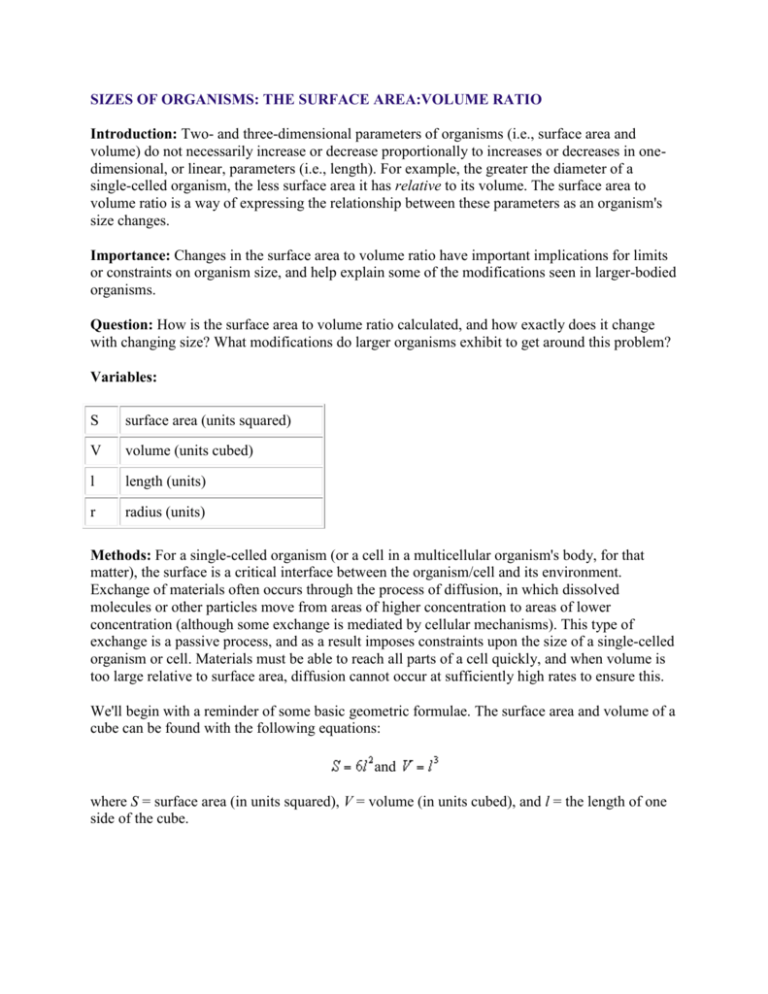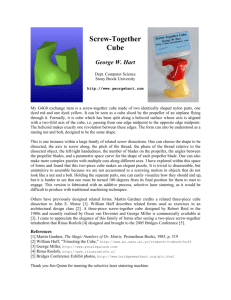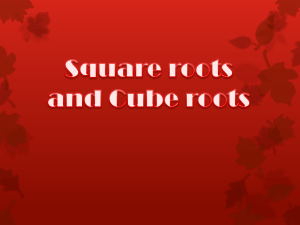SIZES OF ORGANISMS: THE SURFACE AREA:VOLUME RATIO
advertisement

SIZES OF ORGANISMS: THE SURFACE AREA:VOLUME RATIO Introduction: Two- and three-dimensional parameters of organisms (i.e., surface area and volume) do not necessarily increase or decrease proportionally to increases or decreases in onedimensional, or linear, parameters (i.e., length). For example, the greater the diameter of a single-celled organism, the less surface area it has relative to its volume. The surface area to volume ratio is a way of expressing the relationship between these parameters as an organism's size changes. Importance: Changes in the surface area to volume ratio have important implications for limits or constraints on organism size, and help explain some of the modifications seen in larger-bodied organisms. Question: How is the surface area to volume ratio calculated, and how exactly does it change with changing size? What modifications do larger organisms exhibit to get around this problem? Variables: S surface area (units squared) V volume (units cubed) l length (units) r radius (units) Methods: For a single-celled organism (or a cell in a multicellular organism's body, for that matter), the surface is a critical interface between the organism/cell and its environment. Exchange of materials often occurs through the process of diffusion, in which dissolved molecules or other particles move from areas of higher concentration to areas of lower concentration (although some exchange is mediated by cellular mechanisms). This type of exchange is a passive process, and as a result imposes constraints upon the size of a single-celled organism or cell. Materials must be able to reach all parts of a cell quickly, and when volume is too large relative to surface area, diffusion cannot occur at sufficiently high rates to ensure this. We'll begin with a reminder of some basic geometric formulae. The surface area and volume of a cube can be found with the following equations: and where S = surface area (in units squared), V = volume (in units cubed), and l = the length of one side of the cube. The equations for the surface area and volume of a sphere are: and where r is the radius of the sphere. Notice that for any increase, x * l or x * r, in length or radius, the increase in surface area is x squared (x2) and the increase in volume is x cubed (x3). For example, when length is doubled (i.e., x = 2) surface area is quadrupled (22 = 4) not doubled, and volume is octupled (23 = 8) not tripled. Similarly when length is tripled (x = 3) surface area is increased ninefold (32 = 9) and volume is increased twenty-sevenfold (33 = 27). The increase in volume is always greater than the increase in surface area. This is true for cubes, spheres, or any other object whose size is increased without changing its shape. Interpretation: Each point on the graph below represents the surface area and volume for cubes that are increasing by one unit in length, starting with a cube with l = 1. The larger orange dot is the size of the cube (l = 6) at which surface area and volume have equal values (although the units are differentó one is units2 and one is units3). For cubes smaller than this, surface area is greater relative to volume than it is in larger cubes (where volume is greater relative to surface area). Sometimes a graph that shows how the relationship between two variables changes is more instructive. For example, a graph of the ratio of surface area to volume, , clearly illustrates that as the size of an object increases (without changing shape), this ratio decreases. Mathematically, that tells us that the denominator (volume) increases faster relative to the numerator (surface area) as object size increases. The star on the line (at l = 6) represents the same point mentioned above: this is the size of the cube where S and V have equal values, and so the surface area to volume ratio is equal to one. Conclusions: Organisms exhibit a variety of modifications, both physiological and anatomical, to compensate for changes in the surface area to volume ratio associated with size differences. One example of this is the higher metabolic rates found in smaller (homeothermic) animals. Because of their large surface area relative to volume, small animals lose heat at much higher rates than large animals, and therefore must produce more heat to offset the effects of thermal conductance. Another example is the variety of internal transport systems that have developed in plants and animals for actively moving materials throughout the organism, thus enabling them to circumvent the limits imposed by passive diffusion. Many organisms have developed structures that actually increase their surface area: the leaves on trees, the microvilli on the lining of the small intestine, root hairs and capillaries, and the convoluted walls of arteries, to name but a few. Additional Questions: Calculate and graph the surface area to volume ratio for spheres increasing in one unit increments (beginning with r = 1). Compare the S:V ratio of spheres and cubes of comparable sizes (2r, or diameter, = l). Extra credit: Graph the surface areas (x axis) and volumes (y axis) of these spheres on a standard plot and a log-log plot. What happens to the line? Why? Sources: Schmidt-Nielson, K. 1984. Scaling: Why is Animal Size so Important? Cambridge University Press, New York, NY. Vogel, S. 1988. Life's Devices: The Physical World of Animals and Plants. Princeton University Press, Princeton, NJ. SURFACE-TO-VOLUME RATIOS IN BIOLOGY These exercises are designed to introduce you to the concept of surface-to-volume ratios (S/V) and their importance in biology. S/V ratio refers to the amount of surface a structure has relative to its size. Or stated in a more gruesome manner, the amount of "skin" compared to the amount of "guts." To calculate the S/V ratio, simply divide the surface area by the volume. In this exercise we will first examine the effect of size, shape, flattening an object, elongating an object on surface-to-volume ratios. Then, we will do some hands-on activities to examine the importance of S/V ratios in two areas, cell size and metabolic rate. Equations to help with the calculations are provided at the end of the exercise. You will be asked to complete an assignment for this activity: Pre-Class Assignment: 1. On a separate sheet of paper, complete Tables 1, 2, 3, & 4. 2. After each table, write a one sentence conclusion for what the data show. 3. Bring a copy of this exercise to class. Post-Class Assignment: 1. On a separate sheet of paper, complete Tables 5&6 2. Write a summary/conclusion for each table/exercise. 3. Write a brief essay (one paragraph) answering any ONE of the "Additional Questions" below. EXERCISE 1. INFLUENCE OF SIZE ON S/V RATIOS. We will use a cube to serve as a model cell (or organism). Cubes are especially nice because surface area (length x width x 6 sides) and volume (length x width x height) calculations are easy to perform. To calculate the surface-to-volume ratio divide the surface area by the volume. Complete the table below for a series of cubes of varying size (equations): Table 1. Effect of increasing size on surface-to-volume ratio Length of a side (mm) Surface Area (mm2) Volume (mm3) Surface/volume ratio 1 2 3 4 5 6 7 8 9 10 Questions and Analysis: 1. Which cube has the greatest surface area? volume? S/V ratio? 2. What happens to the surface area as the cubes get larger? What happens to the volume as the cubes get larger? What happens to the S/V ratio as the cubes get larger? 3. Proportionately, which grows faster - surface area or volume? Explain. 4. If you cut a cube in half, how does the volume, surface area and S/V ratio of one of the resultant halves compare to the original? 5. As the linear dimension of the cube triples, the surface area increase by the (select one: square or cube) of the linear dimension, and the volume increases by the (square or cube) of the linear dimension. 6. Plot, all on one graph, the following: s/v ratio vs. cube size (length in mm); volume vs. cube size (length in mm); and surface area vs. cube size (length in mm). 7. Compare the volume, surface area and S/V ratio of the following: shrew vs. elephant, baby vs. adult, ostrich egg vs. human egg. EXERCISE 2. SHAPE AND S/V RATIOS: In this exercise we will explore the impact of shape on surface to volume ratios. The three shapes given below have approximately the same volume (1 mm3). Complete the calculations for each shape. To calculate the volume of environment within 1.0 mm of the shape, imagine the shape surrounded by a larger shape of the same size that is 1.0 mm bigger on all sides. (equations) Table 2. Effect of shape on surface-to-volume ratios Shape Dimensions (mm) Sphere 1.2 diameter Cube 1 x 1 x1 Filament 0.1 x 0.1 x 100 Volume (mm3) Surface Area (mm2) S/V ratio Volume of environment within 1.0 mm Questions & Analysis: 1. Make a sketch, to scale, of the three objects. 2. Which shape has the greatest surface area? volume? s/v ratio? 3. If you had to select a package with the greatest volume and smallest surface area, what shape would it be? 4. Explain why the shape of animals is basically "spherical", whereas plants and fungi are "filamentous". EXERCISE 3. S/V RATIOS IN FLATTENED OBJECTS: In this exercise we will explore how flattening an object impacts the surface to volume ratio. Consider a box that is 8 x 8 x 8 mm on a side. Then, imagine that we can flatten the box making it thinner and thinner while maintaining the original volume. What will happen to the surface area and s/v ratio as the box is flattened? Complete the table below. (equations) Table 3. Effect of flattening an object on surface-to-volume ratio Box No. Height (mm) Length (mm) Width (mm) 1 8 8 8 2 4 16 8 3 2 16 16 4 1 32 16 5 0.5 32 32 Surface area (mm2) volume (mm3) s/v ratio Questions/Analysis: 1. Explain why leaves are thin and flat. 2. Why do elephants have large, flat ears? 3. How do you think flatworms feed? EXERCISE 4. S/V RATIOS IN ELONGATED OBJECTS: In this exercise we will explore how elongating an object impacts the surface to volume ratio. Consider a box that is 8 x 8 x 8 mm on a side. Then, imagine that we pull on the ends to make it longer and longer while maintaining the original volume. What will happen to the surface area and s/v ratio as the box is flattened? Complete the table below. (equations) Table 4. Effect of elongating an object on surface-to-volume ratio Box No. Length (mm) Height (mm) Width (mm) 1 8 8 8 2 16 4 8 3 32 4 4 4 64 2 4 Surface area (mm2) volume (mm3) s/v ratio 5 128 2 2 Questions/Analysis: 1. Explain the shape of blood vessels. 2. Explain why roots have "hairs." EXERCISE 5. WHY ARE CELLS SMALL? The typical eukaryotic cell is rather small - approximately 100 m in diameter. This exercise is designed to help provide an explanation why cells are not normally larger. Obtain 2 cell models, one small and one large. Measure the length and diameter of each and then record your data in the table below. Place each cell in a bowl containing clear vinegar (BE CAREFUL!). Allow to sit for a few minutes, or until most of the blue color is gone from the smallest cell. Remove the models with a plastic spoon (CAUTION: don't get the vinegar on your hands!!!!) and place it on a piece of paper towel. Then, measure the size of the colored area remaining and record these data in the table below. Complete the calculations. Theory: The cell models are made of a gelatin-like material called agar. The agar has an acidsensitive dye incorporated into it. The dye turns from blue to yellow (clear in the presence of acid). The uptake of acid, and hence colorless areas of the cell models represents the uptake of food/nutrients by the cell. From this, we can calculate the percent of each cell that was fed during the incubation period. Table 5. Effect of cell size on feeding rates (equations) Small Cell diameter (mm) radius (mm) height (mm) Colored Portion Before Feeding (initial) surface area (mm2) volume (mm3) S/V ratio Colored Portion After Feeding diameter (mm) Large Cell (final) radius (mm) height (mm) surface area (mm2) volume (mm3) Percent of volume (cell) fed = (initial volume - final volume)/initial volume x 100 Analysis/Questions: 1. 2. 3. 4. In which cell did the greatest portion get fed? Explain. Which cell would be in greatest danger of starving? Explain. Suggest some reasons why cells are small. If a cell divides in half, how does the volume, surface area and S/V ratio of each new cell compare to that of the original? 5. Explain why the rate of cell growth slows as a cell gets larger. 6. Explain why cells divide when they get large. EXERCISE 6. WHY DO MICE HAVE GREATER METABOLIC RATES THAN ELEPHANTS? It is well known that there is an inverse relationship between body size and metabolic rate. The purpose of this exercise is to determine the reason for this relationship. Procedure: 1. Pack ice around the containers in the pan to a depth of about two inches. Then add cold water to bring the water level up to the top of the ice. 2. Turn on the hot water tap and let it run until the temperature reaches 55-65 (measure with your thermometer). 3. Measure 8 mL of hot water with a pipet and place it into the 30 mL flat-bottomed vial. 4. Place the thermometer in the hot water. At first the temperature will rise. When it begins to fall again, measure the temperature. If it is below 40 C, start again with hotter water. 5. When the temperature reaches 40 C, record the time. Exactly two minutes later record the temperature again. Record your data in the table below. 6. Measure 80 mL of hot water with a graduate cylinder and transfer it to the larger (100 mL) beaker. Then repeat steps 4 & 5. 7. Calculate the initial and final heat content (rows 8 and 10) by multiplying the temperature (rows 7 and 9) by the volume of water (row 4) by the specific heat of water (4.2 joules/cm3 C). [Note - specific heat is an indication of the amount of heat it takes to change the temperature of a substance.] Thus, this equation is: Heat content (joules) = temp. (C) x vol. (cm3) x specific heat of water (4.2 joules/cm3 C) Calculate the total heat loss during the two minute period (row 11) by subtracting the final heat content (row 10) from the initial heat content (row 8). 8. Calculate the relative heat loss (joules lost/cm3) for each volume (row 13) by dividing the total heat loss in column d by the volume of the vessel (row 4). 9. Lastly, measure the height (row 1) and diameter (row 2) of the water in each container and then calculate radius (row 3), volume (Row 4), surface area (row 5) and S/V ratio (row 6) for both containers. Table 6. Effect of size on the rate of cooling (equations) Small Large 8 80 40 40 1. height (cm) 2. diameter (cm) 3. radius (cm) 4. volume (cm3) 5. surface area (cm2) 6. S/V ratio 7. initial temp (C) 8. initial heat content (J) 9. final temp (C) 10. final heat content (J) 11. total heat loss (Joules/2 minute) 12. total heat loss (Joules/min) 13. relative heat loss (J/min/cm3) Analysis/Questions: 1. 2. 3. 4. 5. Which vessel had the greatest volume? surface area? S/V ratio? Which vessel lost more total heat? Did you expect that? Explain. Which vessel lost the most heat relative to its size? Did you expect that? Explain. Which vessel showed the greatest temperature change? To maintain a constant temperature in the vessels, which would have required the most total heat input? Which would have required the most heat proportional to its size? 6. Who will loose more total heat in a given period, an infant or an adult? A mouse or an elephant? Explain. 7. Who will loose more heat relative to its volume, an infant or an adult? A mouse or an elephant? Explain. 8. Who will need to eat the most food, an infant or an adult? A mouse or an elephant? Explain. Who will need to eat the most food relative to size? Explain. 9. Explain why small animals have a higher metabolic rate than large animals 10. Explain why shrews are voracious feeders. ADDITIONAL QUESTIONS: (answer one of these for your post assignment) 1. 2. 3. 4. 5. Explain why cats can fall off of tall buildings and survive. Why do people splat? Explain the advantages/disadvantages of block vs cube ice. Describe the scientific inaccuracy in the episode of Goldilocks and the porridge. Explain why lungs, gills and intestines have the shape they do. Explain why plants are essentially a cluster of filaments, whereas animals are blobs. In other words, why is a thin, elongated rectangle a good model for a plant, but a square a good model for an animal? 6. Describe the shape of a radiator? Explain why it has this shape. 7. Medieval churches were often built in the shape of a crucifix. Explain why. 8. Mice have large eyes relative to size and elephants small ones. Explain why. Are large eyes better than small ones? 9. The earth is geologically active (has a molten core) but the moon is apparently no longer geologically active. Explain why using S/V ratios. 10. Based on size relationships, explain why a human is smarter than a mouse. 11. Shrews have a reputation for being "mean". In other words, they must feed constantly. Explain why. 12. Why are there few small animals in the arctic? 13. Why would a mouse-sized human lack intelligence? 14. Explain how S/V ratios relate to the form of plants that have evolved in mesic, xeric and hydric environments. 15. Explain why the cells of the spongy layer of a plant leaf are irregularly shaped. References: Barrett, D. 1983. Body size and temperature: an extended approach. J. Biol. Educ. 71:78. Cohen, A, AB Moreh, R Chayoth. 1999. Hands-on Method for Teaching the Concept of the Ratio Between Surface Area & Volume. The American Biology Teacher 61: 691 696. Diamond, Jared. 1989. How cats survive falls from New York skyscrapers. Natural History, August, pp 20 - 26. Haldane, J.B.S. On Being the Right Size. Gould, S. 1977. Size and shape. In Ever Since Darwin. Norton, NY. Moog, F. (1949) Gulliver was a bad biologist. Scientific American 18(5): 52 - 56 (November) Stanek, Jr., J. A. (1983) Why don't cells grow larger? American Biology Teacher 45:393395. Flannery, M (1986) Why is size so important? American Biology Teacher 51: 122 - 125. Morowitz, H (19 ) Of mammals great and small. In The Wine of Life. St. Martin's Press. Went, FW (1968) The size of man. Scientific American 56: 400 - 413. Built to scale. (1999) Science News 156: 249 - 251. Useful Equations: Shape cube Equation for Volume lxwxh box lxwxh (filament) Equation for Surface Area l xwx6 determine SA for each side then add sphere 4/3 () r3 = 4.189 r3 4 () r2 = 12.57 r2 cylinder r2 l 2 r2 + 2 r h = 2 r (r + h) Supplies Required: Cell Exercise: Small tray with 2-3 paper towels, spoon, jar of vinegar, ruler, pair of gloves (1/group); cell models (1 of each size per group; 0.04% bromocresol green, 2% agar) Heat/Metabolism Demo: 2 pans with 8 and 80 ml beakers glued into the bottom; 2 thermometers; hot plate; flask with water; 100 ml graduate cylinder; 10 ml pipet and pump; ice; hot pad/glove Last updated: Visitors to this site: © Copyright by SG Saupe / URL:http://www.employees.csbsju.edu/ssaupe/index.html Question To stay alive, cells must maintain their metabolism. To do this, cells must get materials into and out of the cell. What is the advantage of having a large surface area? What might be disavantages of having a large volume? Answer Hi Sam: I think I can answer in this way: There is a math principle called the scale effect which states that as a solid body gets larger that surface area to volume ratio gets smaller. Example Consider a cube with a side of 1mm SA = 1x1x6 or 6 square mm VOL 1x1x1 or 1 cubic mm ratio 6-1 Now double the size of the cube (side = 2 mm) SA 2x2x6 = 24 square mm VOL 2x2x2 = 8 cubic mm ratio = 3-1 Remember that if a cell gets larger the metabolic needs increase and all exchanges occur through the surface area. So as the cell increases in size the needs are greater but the surface becomes too small to accomadate. Resuit: The cell must divide Question I have read your sticky in homework and have done all the steps that you provided, and there is no information in the textbook, or on the internet that I could find. So please, could someone tell me or provide me a link for: -What are the advantages to having a large surface area in a cell?(I thought that was not a good thing ) -What are the disadvantages to having a large volume in a cell? Ans Cell size is limited by surface to volume ratio. Cells are small so they can exchange materials with their surroundings. Surface area relative to the volume decreases as size of cell increases. This limits the size of cells The more surface area the cell has, the more area there is to exchange materials with the outside environment. Large internal volume relative to surface area makes it more difficult to traffic materials into and out of the cell wer






